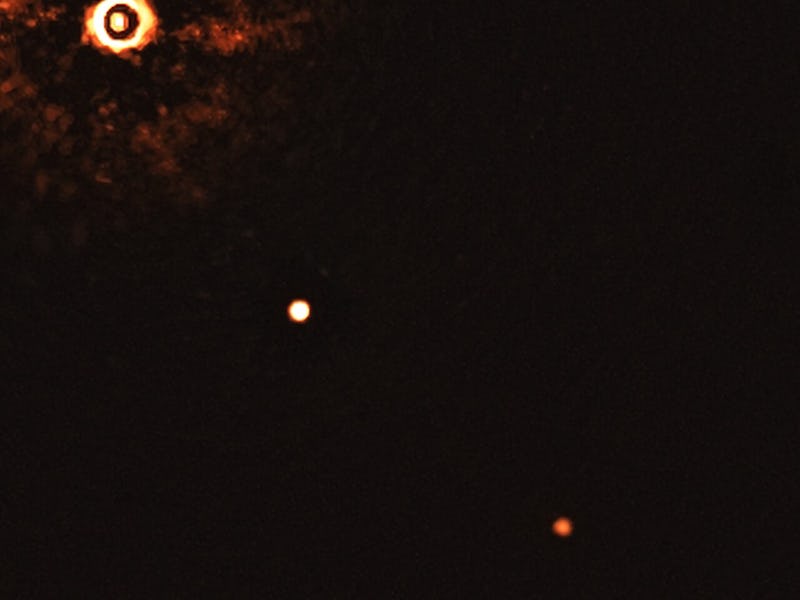Incredible images show a rare cosmic phenomenon for the first time
It's like looking at a younger version of our Solar System.

For the first time ever, astronomers have glimpsed a star system that resembles a younger version of our own Solar System.
The European Southern Observatory (ESO) captured the first images of this multiple-planetary system, revealing two giant planets orbiting a star similar to the Sun. This marks the first time astronomers have been able to directly observe a star system with multiple planets.
The discovery, detailed in a study published Wednesday in The Astrophysical Journal Letters, will be used to help astronomers determine how planets like our own formed and evolved.
The image,shows the star TYC 8998-760-1 accompanied by two giant exoplanets, TYC 8998-760-1b and TYC 8998-760-1c, which appear as two bright dots in the center and bottom right.
The image was captured using ESO's Very Large Telescope, located in the Atacama Desert of northern Chile. By blocking the light being emitted by the star, astronomers were able to see the two surrounding exoplanets which appear as the two bright dots in the center of the image and at the bottom right corner.
The team of astronomers behind the discovery was scouring the cosmos for young, massive planets that orbit stars like our Sun when they stumbled upon this star system.
“This discovery is a snapshot of an environment that is very similar to our Solar System, but at a much earlier stage of its evolution,” Alexander Bohn, a Ph.D. student at Leiden University in the Netherlands, and lead author behind the new study, said in a statement.
The star, dubbed TYC 8998-760-1, is located about 300 light-years away in the Southern constellation of Musca. It is similar to our Sun, albeit a younger version of our host star. TYC 8998-760-1 is only a mere 17 million years old, while our Sun is a middle-aged star of around 4.5 billion years old.
The two surrounding exoplanets are massive gas giants. TYC 8998-760-1b is around 14 times more massive than Jupiter, the largest planet in the Solar System, and orbits at an average distance of 160 astronomical units (AU), while TYC 8998-760-1c is six times more massive than Jupiter and orbits the host star at a distance of about 320 AU. An astronomical unit is the average distance between the Sun and the Earth, which puts these two exoplanets at a much further distance than any planet in our Solar System.
Jupiter orbits the Sun at a distance of five AU, while Saturn orbits at a distance of 10 AU.
In the hunt for exoplanets in the vast universe, astronomers have detected thousands of these strange worlds. However, only a fraction of those exoplanets have been directly imaged, according to the researchers.
And of those that were directly observed and captured in images, only two of them have been of two or more exoplanets orbiting around a star and the stars were very different to our own Sun. However, this discovery marks the first time that a multiple-planet system with a Sun-like star was imaged.
The reason why it is significant is because the newly imaged star system can inform us of our own origin story, and how the Solar System evolved and developed over these past few billion years.
The team will conduct further observations of the star system in order to determine whether the two exoplanets formed in their current positions, or if they migrated from elsewhere. They are also curious about whether or not more exoplanets surround this young star, and if they can be detected with the upcoming Extremely Large Telescope (ELT), scheduled to begin surveying the skies in the year 2025.
“The possibility that future instruments, such as those available on the ELT, will be able to detect even lower-mass planets around this star marks an important milestone in understanding multi-planet systems, with potential implications for the history of our own Solar System," Bohn said.
Study abstract: Even though tens of directly imaged companions have been discovered in the past decades, the number of directly confirmed multiplanet systems is still small. Dynamical analysis of these systems imposes important constraints on formation mechanisms of these wide-orbit companions. As part of the Young Suns Exoplanet Survey we report the detection of a second planetary-mass companion around the 17 Myr-old, solar-type star TYC 8998-760-1 that is located in the Lower Centaurus Crux subgroup of the Scorpius–Centaurus association. The companion has a projected physical separation of 320 au and several individual photometric measurements from 1.1 to 3.8 microns constrain a companion mass of 6 ± 1 M Jup, which is equivalent to a mass ratio of q = 0.57 ± 0.10% with respect to the primary. With the previously detected 14 ± 3 M Jup companion that is orbiting the primary at 160 au, TYC 8998-760-1 is the first directly imaged multiplanet system that is detected around a young, solar analog. We show that circular orbits are stable, but that mildly eccentric orbits for either/both components (e > 0.1) are chaotic on gigayear timescales, implying in situ formation or a very specific ejection by an unseen third companion. Due to the wide separations of the companions TYC 8998-760-1 is an excellent system for spectroscopic and photometric follow-up with space-based observatories such as the James Webb Space Telescope.
This article was originally published on